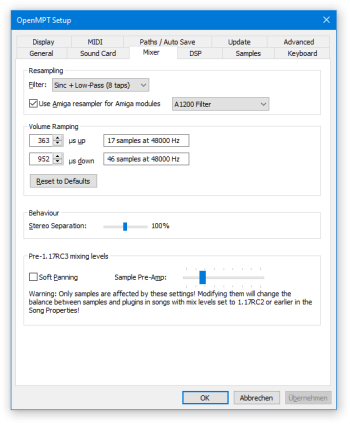Manual: Setup/Mixer

The settings on this page influence how the OpenMPT mixer renders the audio data.
Resampling[edit]
OpenMPT needs to resample/interpolate samples when their sampling rate does not match the output rate or when they are played at a different pitch.
Filter[edit]
The default sample interpolation filter can be set here. You can also set the Resampling algorithm separately for each Instrument.
Interpolation is done whenever a sample has to be resampled from one sampling rate for another. For example, playing a 22 kHz sample in a module that is played back at 44 kHz requires the sampling rate of the sample to be doubled. The most primitive resampling algorithm, “no interpolation”, just repeats sampling points (in the example, it doubles them). This is very cheap mathematically, but also introduces unwanted frequencies into the resampled sample that should not be there. This is called aliasing. For lo-fi samples such as in chiptunes, this effect can actually be desired.
All the more sophisticated resampling methods try to get rid of this aliasing noise in different ways. While Linear interpolation (2 taps) is the most primitive in mathematics (apart from "No Interpolation", obviously), it is also the harshest in sound quality. Cubic interpolation (4 taps) sounds slightly better and with the 8-tap Sinc filters, there is a definite improvement. In addition to the regular Sinc filter, Sinc with Low-Pass additionally applies a slight low-pass filter when downsampling which reduces aliasing a bit.
On modern systems, it is recommended to use one of the two higher quality 8 tap filters. If you have a slower system, try cubic interpolation which does not decrease sound quality too much in comparison to the 8 tap filters. If you care about faithful replay of older module files, you may prefer to use No (especially for Amiga tracks) or Linear Interpolation.
Legacy information[edit]
In OpenMPT 1.28, the names of some of the resampling filters were changed into more generic, less confusing names:
- XMMS-ModPlug is now Sinc
- Polyphase is now Sinc + Low-Pass
Use Amiga resampler for Amiga modules[edit]
Enabling this option overrides the interpolation filter specified in the previous settings for Amiga modules (e.g. DIGI, ICE, MOD, MED, SFX, ST26, STP, ...) with a resampler that models the output of the Amiga sound chip (Paula) more closely, at the expense of a slightly higher CPU consumption compared to other resamplers. The setting does not affect non-Amiga formats.
- For individual modules, the Amiga resampler can be overridden by the Resampling option on the General Tab of the module.
- When enabling this option, the E0x effect can be used in MOD files to toggle the Amiga LED filter.
- When writing new modules in OpenMPT, the Amiga resampler is only available in 4-channel MOD files that solely contain notes in the range C-4 to B-6.
- It is recommended to set the sample rate to at least 44100 Hz when using the Amiga resampler.
- The filter characteristics of several Amiga models can be emulated: Amiga 500 (dull sound), Amiga 1200 (bright sound), and unfiltered output. In the latter case, the E0x effect does not influence the output.
Volume Ramping[edit]
Ramping is applied to samples to avoid clicks at the beginning and the end of the sample in order to avoid unwanted clicks from bad DC offsets. The default ramp settings can be configured here, but they can also be overridden by an instrument-specific setting.
- up applies “fade-in” to the samples in an effort to dampen the clicks that come with poorly assembled sample waveforms, or from offset commands that “break into” a loud spot in the sample.
- down fades out the end of a sample that is stopped through note cuts. However, samples that end on their own are not affected by the ramping value, as a different fade-out slope is used there to prevent clicks from samples that do not end on zero level.
Ramping also makes volume slides smoother, so changing volume levels rapidly does not cause clicks.
Using the Reset to Defaults button reverts both ramping values to their respective default settings.
Stereo Separation[edit]
Allows for greater separation of the stereo channels; moving the slider modifies the amount of stereo separation. On headphones, it may be desirable to set this value to something below 100%, while on a normal speaker setup, stereo separation should be kept at 100%. If your speakers are too close to each other, it might help to increase stereo separation.
Legacy Options[edit]
These options are only provided for modules that use legacy mix levels MPT 1.16, 1.17 RC1 and 1.17 RC2. They only affect samples — instrument plugins are not affected, which can lead to problems with modules that use both samples and plugins. If you have such modules which use legacy mix levels, you should not touch these settings.
Soft Panning[edit]
Originally thought of as a special panning mode that sounds more pleasant on headphones, this panning mode is forced when using RC3 Mix Levels and always disabled when using Compatible Mix Levels. As this can drastically alter the sound of stereo modules, it should not be enabled.
Pre-Amp[edit]
An obsolete feature which boosts the volume of all samples. When using RC3 or Compatible Mix Levels, the Pre-Amp Level is overridden and a default value is used.